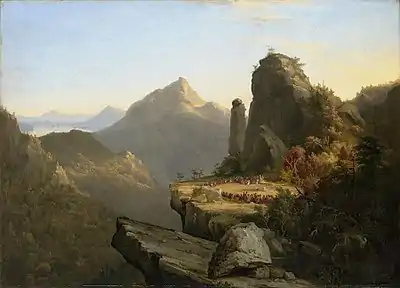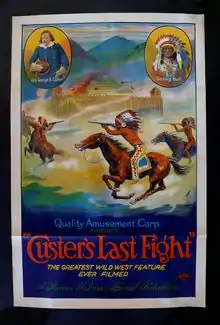Native Americans in popular culture
The portrayal of Indigenous people of the Americas in popular culture has oscillated between the fascination with the noble savage who lives in harmony with nature, and the stereotype of the uncivilized Red Indian of the traditional Western genre. The common depiction of Indigenous Americans and their relationship with European colonists has changed over time. Today indigenous Americans live completely differently than they once did, yet retain much of their cultural beliefs and traditional practices.

History
In 1851, Charles Dickens wrote a scathingly sarcastic review in his weekly magazine, Household Words, of painter George Catlin's show of American Indians when it visited England. In his essay, entitled The Noble Savage,[1] Dickens expressed repugnance for Indians and their way of life, recommending that they ought to be "civilized out of existence". (Dickens' essay refers to Dryden's use of the term, not to Rousseau.[2]) Dickens' scorn for those unnamed individuals, who, like Catlin, he alleged, misguidedly exalted the so-called "noble savage", was limitless. In reality, Dickens maintained, Indians were dirty, cruel, and constantly fighting among themselves. Dickens' satire on Catlin and others like him who might find something to admire in the American Indians or African bushmen is a notable turning point in the history of the use of the phrase.[3]
In Leslie Marmon Silko's story "untitled; from ceremony" she states how "when they look they see no objects, the world is a dead thing to them".[4] This explains how the white people viewed land as an object instead of a living breathing thing like the Native Americans did. Because the white people viewed this land as an object, they forced the Natives out of their land so they could industrialize, etc. Thousands of Native Americans lives were lost during this process.
Eastern European-produced Westerns were popular in Communist Eastern European countries, and were a particular favorite of Joseph Stalin. "Red Western" or "Ostern" films usually portrayed the American Indians sympathetically, as oppressed people fighting for their rights, in contrast to American Westerns of the time, which frequently portrayed the Indians as villains.
The concept of Native Americans living in harmony with nature was taken up in the 1960s by the hippie subculture and played a certain role in the formative phase of the environmentalist movement. The so-called Legend of the Rainbow Warriors, an alleged Hopi prophecy foretelling environmental activism,[5] became popular, with most proponents unaware that the story is untrue, written as part of an evangelical Christian tract, and an attempt to destroy traditional Native religions.[5]
In the US cultural mainstream, negative depiction of Native Americans came to be seen as racist in the 1980s, as reflected in the production of western films emphasizing the "noble savage" such as Dances with Wolves (1990).[6]
Comics
Native American characters in comic books and comic strips include Akwas, a comic strip about Native Americans created by Mike Roy, and Super-Chief, an Indian superhero created for DC Comics.
Italian comic books featuring Tex Willer prominently feature Native Americans in their pilota, starring from the first story, "Il totem misterioso" (lit. 'The mysterious totem').
European comics of the mid 20th century usually ridiculed Indians as goofy comedic characters. Examples include Little Plum, Oumpah-pah and Big Chief Keen-Eyed Mole.
Music
Since the turn of the century, heroic Indian braves and their devoted squaws have been the subject of popular songs. Early examples include "Red Wing" and "Cherokee Maiden" by Bob Wills.
More recent songs about the Indians include "Running Bear" by the Big Bopper, "Apache" by the Shadows, "Soldier Blue" by Buffy St Marie, "Wig Wam Bam" by the Sweet, "Run to the Hills" by Iron Maiden, "Creek Mary's Blood" by Nightwish, and "Wovoka" by Redbone.
Film

In films such as Northwest Passage (1940), Native Americans are the villains, attacking White settlers, often at the instigation of unscrupulous White men. But there are many Hollywood films that offer a more sympathetic picture. Most of the John Ford Westerns show respect toward American Indians, and they are the heroes of such major films as Broken Arrow (1950) and Dances With Wolves (1990). Probably the most famous "Indian" in American popular media is the Lone Ranger's sidekick, Tonto, most famously portrayed by Native American actor Jay Silverheels.
Literature
James Fenimore Cooper featured a character called "The Sagamore" in his 1826 novel The Last of the Mohicans.
Rick, the protagonist of Simon Spurrier's novel, The Culled (2006, book 1 of The Afterblight Chronicles), belongs to the Haudenosaunee people and is guided through crises by the sachem. Another character, named Hiawatha,[7] saves Rick's life and advises him the Tadodaho have said Rick and Hiawatha are aligned.[8]
Throughout Sherman Alexie's poem, "How to Write the Great American Indian Novel" he states that all of the Indians must have tragic noses, eyes, and arms. Their hands and fingers must be tragic when they reach for tragic food. Natives are portrayed with tragic features because it resembles their tragic history.[9] "The hero must be a half-breed, half white and half Indian, preferably from a horse culture. He should often weep alone. That is mandatory". Males are depicted as being the strong warriors. Males are also often depicted as wearing headdresses in popular culture. "If the hero is an Indian women, she is beautiful. She must be slender and in love with a white man". In popular culture women are depicted in a sexualized form. Women are depicted as not portraying strength. However, Native American women are very strong. They picked berries and looked after the kids.
In Vine DeLoria's story, "Indian Humor" he states that "It has always been a great disappointment to Indian People that the humorous side of Indian life has not been mentioned by professed experts on Indian affairs".[10] Native Americans are seen as always being serious and warriors. However, Native Americans are humorous and have a completely different side to them than most people think. Native Americans can be serious and warriors but they can also be humorous and comforting. Native Americans actually use humor to joke about their brutal history. It is their way of coping. The fact that they are willing to allow humor to joke around about their past and the killing of thousands of Native Americans proves that they are not savages. Instead, they are casual everyday people
Video games
A Lakota-Sioux warrior named Nightwolf debuted in the video game Mortal Kombat 3 (1995) and has been a recurring protagonist of the franchise. He is one of the few mortals who are spiritually aware, acting as a historian and shaman of his people.
In American Conquest (2003), various native tribes and empires during the colonisation of the Americas by Europeans are depicted.
In Red Dead Revolver (2004), the protagonist Red Harlow is half Native American on his mother's side.
In Age of Empires III (2005), several native tribes featured in the game, three of these tribes were made playable in the expansion pack Age of Empires III: The WarChiefs.
In Prey (2006), the protagonist, Tommy, is a mechanic of Cherokee heritage, who is sick of life on the reservation and resents his heritage. In the beginning of the game, after a bar fight, the building is lifted up by a hostile alien ship, and he and his family are abducted. As the game progresses, he must fight to escape.
In Red Dead Redemption (2010), disaffected Native Americans form most of a gang led by Dutch Van Der Linde, a major antagonist of the game. A Native American called Nastas aids the protagonist John Marston in stopping the gang because while he shares their resentment for the government's treatment of natives he does not agree with opposing them in such a radical way. The prequel Red Dead Redemption 2 also features Native Americans in a more prominent role in the form of Wapiti Indians led by Rains Fall and including members such as his son Eagle Flies. Additionally a Van der Linde gang member and major character in the game Charles Smith is a half-Native American and later joins the Indians for sometime after he leaves Dutch and the gang due to the latter's deteriorating state.
In Assassin's Creed III (2012), set during the American Revolution, the protagonist is a half English, half Mohawk Native American named Ratonhnhaké:ton.[11]
In Infamous: Second Son (2014), the protagonist Delsin Rowe and his brother Reggie are members of a fictional Native American tribe called the Akomish.[12]
In Assassin's Creed: Rogue (2014), an Abenaki Assassin named Kesegowaase is a minor antagonist, the protagonist Shay Cormac also encounters members of the Oneida tribe.
See also
References
- "The Noble Savage"
- Earl Miner, "The Wild Man Through the Looking Glass", in Edward Dudley and Maximillian E. Novak, editors, The Wild Man Within: An Image in Western Thought from the Renaissance to Romanticism, University of Pittsburgh Press, 1972, p. 106 and Ellingson (2001), p. 8 and passim. In 2009, Peter Gay remarked, "As far as the noble savage is concerned, that phrase is from Dryden and does not appear in Rousseau's writings. In the years I taught the history of political theory at Columbia to a sizable class of undergraduates, I would offer students a hundred dollars if they could find 'Noble Savage' anywhere in Rousseau. I never had to pay up'", Peter Gay, "Breeding is Fundamental", Book Forum, April/May 2009.
- For an account of Dickens' article see Grace Moore, "Reappraising Dickens's 'Noble Savage'", The Dickensian 98:458 (2002): 236-243. Moore speculates that Dickens, although himself an abolitionist, was motivated by a wish to differentiate himself from what he believed was the feminine sentimentality and bad writing of Harriet Beecher Stowe, with whom he, as a reformist writer, was often associated.
- Marmon Silko, Leslie (2001). untitled;from ceremony. p. 541. ISBN 0-13-011642-4.
- Tarleton, John (July 1999). "Interview with Michael Niman". John Tarleton. Retrieved May 18, 2014. This work by a journalist is independent of the source, Niman, and is probably reliable.
- Melichar, Kenneth E. (2009). "The Filmic Indian And Cultural Tourism: Indian Represent Ations During The Period Of Allotment And Forced Assimilation (1887-1928)" (PDF). University of Georgia (Doctoral Thesis). p. 21 and passim. Retrieved May 17, 2014.
- See Hiawatha and Longfellow's The Song of Hiawatha.
- Spurrier, Simon (2006). The Culled. Abaddon Books. ISBN 9781849970136.
- alexie, Sherman (2001). how to write the great American Indian novel. p. 425. ISBN 0-13-011642-4.
- DeLoria, Vine (2001). Indian Humor. p. 39. ISBN 0-13-011642-4.
- Olp, Susan (November 29, 2012). "Crow actor stars in Assassin's Creed III video game". Billings Gazette. Retrieved September 26, 2016.
- Gravning, Jagger (May 1, 2014). "Even Superpowers Can't Separate Seattle From Its Dark Past". Kotaku. Retrieved September 26, 2016.